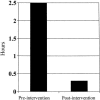Hospitalists and an innovative emergency department admission process
- PMID: 15009782
- PMCID: PMC1492152
- DOI: 10.1111/j.1525-1497.2004.30431.x
Hospitalists and an innovative emergency department admission process
Abstract
After treatment in an emergency department (ED), patients often wait several hours for hospital admission, resulting in dissatisfaction and increased wait times for both admitted and other ED patients. We implemented a new direct admission system based on telephone consultation between ED physicians and in-house hospitalists. We studied this system, measuring admission times, length of stay, and mortality. Postintervention, admission times averaged 18 minutes for transfer to the ward compared to 2.5 hours preintervention, while pre- and postintervention length of stay and mortality rates remained similar.
Figures
Similar articles
-
Hospitalist bed management effecting throughput from the emergency department to the intensive care unit.J Crit Care. 2010 Jun;25(2):184-9. doi: 10.1016/j.jcrc.2009.08.004. Epub 2009 Oct 13. J Crit Care. 2010. PMID: 19828284
-
Active bed management by hospitalists and emergency department throughput.Ann Intern Med. 2008 Dec 2;149(11):804-11. doi: 10.7326/0003-4819-149-11-200812020-00006. Ann Intern Med. 2008. PMID: 19047027
-
The effect of hospital occupancy on emergency department length of stay and patient disposition.Acad Emerg Med. 2003 Feb;10(2):127-33. doi: 10.1111/j.1553-2712.2003.tb00029.x. Acad Emerg Med. 2003. PMID: 12574009
-
International perspectives on emergency department crowding.Acad Emerg Med. 2011 Dec;18(12):1358-70. doi: 10.1111/j.1553-2712.2011.01235.x. Acad Emerg Med. 2011. PMID: 22168200 Review.
-
The evolution of ED crowding.J Emerg Nurs. 2014 Mar;40(2):153-60. doi: 10.1016/j.jen.2013.01.013. Epub 2013 Mar 6. J Emerg Nurs. 2014. PMID: 23481863 Review. No abstract available.
Cited by
-
Multicentre, prospective observational study of the correlation between the Glasgow Admission Prediction Score and adverse outcomes.BMJ Open. 2019 Aug 10;9(8):e026599. doi: 10.1136/bmjopen-2018-026599. BMJ Open. 2019. PMID: 31401591 Free PMC article.
-
A simple tool to predict admission at the time of triage.Emerg Med J. 2015 Mar;32(3):174-9. doi: 10.1136/emermed-2013-203200. Epub 2014 Jan 13. Emerg Med J. 2015. PMID: 24421344 Free PMC article.
-
Evaluating the Outcome of Multi-Morbid Patients Cared for by Hospitalists: a Report of Integrated Medical Model in Korea.J Korean Med Sci. 2019 Jul 1;34(25):e179. doi: 10.3346/jkms.2019.34.e179. J Korean Med Sci. 2019. PMID: 31243937 Free PMC article.
-
Admission Decisions Made by Emergency Physicians Can Reduce the Emergency Department Length of Stay for Medical Patients.Emerg Med Int. 2020 Feb 11;2020:8392832. doi: 10.1155/2020/8392832. eCollection 2020. Emerg Med Int. 2020. PMID: 32104606 Free PMC article.
-
Outcomes of a Neurohospitalist Program at an Academic Medical Center.Neurohospitalist. 2022 Jul;12(3):453-462. doi: 10.1177/19418744221083182. Epub 2022 Apr 22. Neurohospitalist. 2022. PMID: 35755235 Free PMC article.
References
-
- Meggs WJ, Czaplijski T, Benson N. Trends in emergency department utilization. Acad Emerg Med. 1999;6:1030–5. - PubMed
-
- Andrulis DP, Kellermann A, Hintz EA, Hackman BB, Weslowski VB. Emergency departments and crowding in the United States teaching hospitals. Ann Emerg Med. 1991;20:980–6. - PubMed
-
- Bazarian JJ, Schneider SM, Newman VJ, Chodosh J. Do admitted patients held in the emergency department impact the throughput of treat-and-release patients? Acad Emerg Med. 1996;3:1113–8. - PubMed
-
- Quick G. Time analysis of consult service emergency department admission process compared with emergency medicine service admission process. J Emerg Med. 1999;17:815–22. - PubMed
-
- Wachter RM, Goldman L. The hospitalist movement 5 years later. JAMA. 2002;287:487–94. - PubMed
MeSH terms
LinkOut - more resources
Full Text Sources

